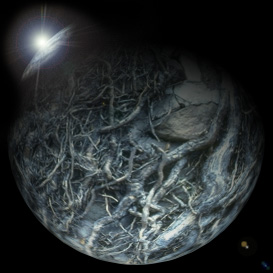| Rhizomes | 2004-10-15 23:59 1 comment |
 by Flemming Funch by Flemming FunchRhizome: expanding underground root system, sending up above ground shoots to form a vast network. Difficult to uproot.Deleuze & Guattari seems to be the folks who've evangelized it a model for organization and for the Internet. Well, they sort of predate the popularization of the Net, but it seems to be a natural fit. Seems to be most popular with an assortment of alternative art collectives. Deleuze & Guattari wrote a lot of stuff which seems inspiring, but not easily penetrable. So let me just pick out a few things from what others' quote, like here or here, to elaborate on the rhizone meme. Note first of all that rhizome is often meant as contrasted to or opposed to the model of a tree. A tree in this context representing hierarchy and linear thinking. We're tired of trees. We should stop believing in trees, roots, and radicles. They've made us suffer too much. All of arborescent culture is founded on them, from biology to linguistics. ...So, the rhizome is the alternative. A more organic structure without any centralized, hierarchical organization. Any point of a rhizome can be connected to any other, and must be. This is very different from the tree or root, which plots a point, fixes an order. ...So, they invite us to become rhizomes. Something that infiltrates and subverts tree structures. Something that sprouts transformative connections everywhere, but which is impossible to pin down. Something that can't be reduced to a managable simplicity. To be rhizomorphous is to produce stems and filaments that seem to be roots, or better yet connect with them by penetrating the trunk, but put them to strange new uses. ...Cool, count me in. I'm a rhizome. Here's some poetic advice from them: "Write to the nth power, N-1, write with slogans: Form rhizomes and not roots, never plant! Don't sow, forage! Be neither a One nor a Many, but multiplicities! Form a line, never a point! Speed transforms the point into a line. Be fast, even while standing still! Line of chance, line of hips, line of flight. Don't arouse the General in yourself! Not an exact idea, but just as idea (Godard). Have short-term ideas. Make maps, not photographs or drawings. Be the Pink Panther, and let your loves be like the wasp and the orchid, the cat and the baboon. As they sing of old man river:One could discuss whether the Internet really is the perfect substrate for rhizomes. Like, see Robin B. Hamman: Rhizomes and the Internet. Despite that the Net seems to give space to all these subversive activities and free networking and peer-to-peer, it is in many ways designed as a hierarchy. Think about DNS and the Registrar system. Authorities hand out authority to lesser authorities. And think about that most of you have only one access point to the Net, your DSL or dial-up provider, who routes everything you do. Related to that subject, see Questioning Protocol. Even after widespread decentralization, control remains. Doesn't matter how much IBM splits into decentralized teams, it is still IBM, with essentially the same hierarchy. Doesn't matter how many P2P networks you set up, they still run through a few central routers run by a handful of agencies.He don't plant tatosA rhizome doesn't begin and doesn't end, but is always in the middle, between things, interbeing, intermezzo." But, hey, it can all by rhizomized, I suppose. Might be worthwhile to pay close to attention to which structures and technologies are inherently hierarchical (even if they aren't used as such) and which ones aren't. And consistently choose the ones that subvert unnecessary hierarchies. |